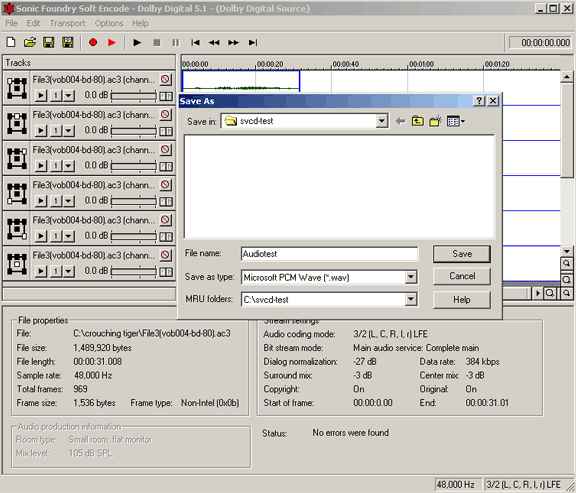Sonic Foundry Dolby Digital Ac3 5.1 Soft Encoder

How to Properly Encode Dolby Digital Audio (AC3) Introduction Many people on the forum have experienced problems when encoding audio using Dolby Digital. These problems are primarily volume-related, with some dynamic range compression issues as well.
This guide aims to educate about how Dolby Digital audio should be encoded, and how to make it sound best. References The primary references for the information contained in this guide are two guides on Dolby's web site. The first is, which has the best information on Dynamic Range Compression. The other is which gives an excellent explanation of the dialogue Normalization parameter. You will need to view these.pdf documents.
How to Properly Encode Dolby Digital Audio (AC3). I have personally tested the Sonic Foundry 5.1 Plug-In. The Dolby Digital encoder offers 5 different. Multichannel Audio Technologies: Lecture 8. For our purposes we can use ‘Sonic Foundry Softencode’ to encode Dolby. The Dolby Digital encoder offers 5.
Philosophy of Dolby Digital Dolby Labs has been doing high-quality audio with cutting-edge techniques for a long time, using their past experience as a guide. As such, there is often confusion about their methods and philosophy to those of us who are not privy to that information. Of prime example is the current problem: Why is Dolby Digital so much quieter compared to my original sound? Most audio destined for DVDs is audio originally recorded for use in the movie theater. The movie industry has a huge advantage when producing audio for the theater -- the theater has large speakers and amplifiers, and a quiet, near-ideal listening environment. Huge dynamic ranges are possible, where the slightest whisper of dialogue is audible, yet gunshots and explosions can be earth-shattering.
Dolby's dilemma was: 'How do we bring this audio, with its huge dynamic range, into the home?' This is a major problem -- most homes don't have the speakers and amplifiers necessary to shake the living room. Further, background noise in the home can easily drown out those subtleties in the soundtrack. Dolby's answer is to allow the decoder to modify the sound to compensate for these problems. Low-volume sounds are boosted automatically so they can be heard, whereas high-volume sounds are quieted down so that speakers aren't blown and other persons in the home are not disturbed.
Further, Dolby Digital allows for different program material to be equalized, so that volume does not have to be adjusted when switching between inherently quiet programs and inherently loud programs. Decoder Specifics The methods I'm about to present here for encoding Dolby Digital are generic and do not apply specifically to any one encoder. All Dolby-certified encoders (and some non-certified ones) will have the appropriate parameters available to follow this procedure.
I have personally tested the Sonic Foundry 5.1 Plug-In Pack for ACID Pro, as well as Sonic Foundry Soft Encode. These methods should also work for BeSweet, Vegas Video + DVD, Scenarist, and other software-based encoders. Age Of Wonders Shadow Magic Full Game more.
Basic Parameters Every Dolby Digital encoder has some basic parameters that need to be set. The first is the channel combination, presented as (Number of front channels)/(Number of rear channels), with an optional '.1' added to represent a low-frequency-effects (LFE) channel if present. 2/0 represents normal left and right stereo sound.
3/2.1 represents a standard '5.1' setup, of Front Left, Front Right, Front Center, Rear Left, Rear Right, and LFE. This parameter should obviously be set to the number of channels of program material you will be encoding. The other major basic parameter is the bitrate. Obviously, higher bitrates allow for less compression.
Typical bitrates used are 192 kbps for 2/0 program material, and 448 kbps for 5.1 program material. Referencing Volume to a Known Level - Dialogue Normalization To meet the Dolby Digital requirement that different programs should have approximately the same listening level (thus the consumer does not have to adjust volume level between programs), Dolby Digital incorporates a parameter called dialogue Normalization. This metadata parameter tells the decoder how far away from the reference level the average sound pressure level of the material's dialogue is. The movie industry masters their soundtracks in a specific way.
The maximum rated sound level (where all amplifiers are putting out their rated power) is 0 dB. Sounds below that level are rated in terms of how many decibels (dB) they are down from that maximum level. As such, these values are negative. The movie industry typically masters the 'normal' listening level of dialogue (where people are speaking in a normal voice) at -31 dBFS. In other words, a speaking voice is at an average of -31 dB when referenced to the 0 dB maximum sound level, hence the term decibels of full scale (dBFS). Since movie content is the largest class of programs to go on DVD, Dolby chose -31 dBFS as the reference level for audio on DVD, where 0 dB represents the maximum encodable digital sound level (full scale). The dialogue normalization parameter needs to be set to the LAeq level of your program material's dialogue.